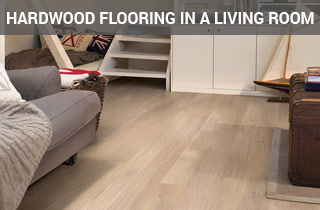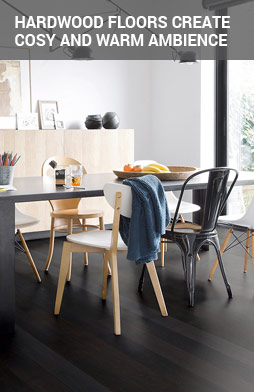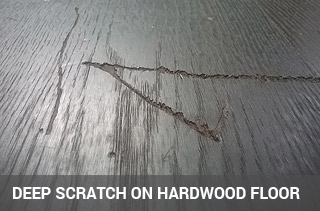Back to Flooring Products
Hardwood Flooring for Living Rooms: Why It’s the Perfect Choice

Hardwood Flooring for Living Rooms: Why It’s the Perfect Choice
The living room is more than just a space where the family gathers — it is the heart of your home. It’s where you relax after a long day, enjoy quality time with loved ones, and welcome friends or visitors. Because of this, the design choices you make here have a huge impact on how warm, stylish, and inviting your entire home feels.
Among all design elements, the floor is the foundation that ties the space together. Choosing the right hardwood flooring for your living room not only enhances its beauty but also ensures lasting comfort and practicality. From rich oak to elegant walnut, wood brings a natural charm that elevates the room’s atmosphere while withstanding daily foot traffic.
Pro Tip: If you’re unsure which type of hardwood floor installation will best suit your living room, consider your lifestyle first. Families with kids or pets may prefer durable finishes like matt lacquer or oil, while homeowners focused on aesthetics can opt for statement woods such as herringbone or wide-plank oak.
Creating the Right Atmosphere with Living Room Flooring

Choosing the right living room flooring sets the mood for the entire home. The floor acts as the backdrop for your décor, furniture, and daily life, so it should complement both your lifestyle and design preferences. From traditional hardwood to versatile laminate, stylish LVT, soft carpets, or even bold choices like brick and concrete for an industrial vibe — the possibilities are endless.
Each option creates a different atmosphere:
- Hard surfaces such as brick or polished concrete provide excellent durability and low maintenance but may feel too cold and impersonal in a family living room.
- Carpets deliver comfort and warmth underfoot, making them cosy for lounging, but they are harder to clean and less durable in busy households.
- Wood flooring offers a timeless balance of elegance, resilience, and comfort. Options like parquet flooring or wide-plank oak can instantly transform your living room into a stylish yet practical space.
Since the living room is a high-traffic zone, it’s important to weigh aesthetics against practicality. Do you value easy maintenance above all else, or do you want a floor that combines beauty, comfort, and long-term durability?
Pro Tip: If you want to make your living room feel larger and more open, choose lighter shades of wood flooring such as ash, maple, or white oak. For a more intimate and dramatic look, darker tones like walnut or smoked oak work beautifully.
Why Choose Hardwood for Your Living Room?

Your living room should feel both warm and impressive — a space that reflects your style while welcoming family and guests. Just as fashion choices reveal personality, flooring sets the tone for your interiors. Choosing hardwood flooring for a living room is one of the best ways to combine elegance, comfort, and practicality in a single choice.
Hardwood remains a premium flooring solution because it delivers benefits that few other materials can match:
- Timeless Appeal: Real wood instantly elevates your space with natural warmth, character, and sophistication — perfect for both modern and traditional living rooms.
- Built to Last: With the right care, hardwood floors can last a lifetime, often outliving laminate, carpet, or vinyl alternatives.
- Simple Upkeep: Day-to-day maintenance is straightforward — a quick sweep and occasional mop keep the surface looking fresh.
- Refinishing Power: Unlike man-made floors, hardwood can be sanded and refinished multiple times, giving you the option to refresh its look or even change the stain colour when your style evolves.
- Healthier Homes: Wooden floors don’t trap allergens, dust, or pet hair, making them a hygienic and family-friendly option.
While vinyl and laminate can mimic the look of wood, they lack the authentic feel, durability, and refinishing potential of true hardwood. Over time, these differences become clear, which is why solid and engineered wood flooring remains the go-to choice for homeowners who value long-term quality.
Pro Tip: If you want your investment to last, pair your hardwood floor with a durable finish such as oil or lacquer, and consider adding gap filling for extra stability and insulation in older homes.
How to Care for Hardwood Flooring in Your Living Room

While hardwood flooring adds warmth, elegance, and timeless style to your living room, it does require thoughtful care. As one of the busiest spaces in the home, the living room floor faces daily challenges — from accidental spills to dents, scratches, and wear from constant use. With proper maintenance, however, you can keep your wooden floor looking stunning for decades.
For long-term durability, solid hardwood flooring often provides better value than engineered alternatives, as it can be sanded and refinished multiple times. This means you can refresh its look whenever it shows signs of wear, without the need for a full replacement.
Common Hardwood Floor Challenges & How to Solve Them
- Foot Traffic & Pets: Large dogs and active households can leave scratches behind. Consider distressed or hand-scraped wood flooring that naturally disguises marks while adding unique character.
- Furniture Damage: Protect against dents and scratches by adding felt pads under chair and table legs. Always lift furniture instead of dragging it.
- Shoes & High Heels: Stilettos and hard-soled shoes can quickly damage the surface. A simple “no shoes indoors” rule will significantly extend your floor’s life.
- Sunlight Exposure: Prolonged UV light can cause fading or discolouration. Use blinds, curtains, or a protective finish with UV resistance to maintain even colouring.
- Cleaning & Maintenance: Sweep or vacuum regularly to remove abrasive dirt and grit. Placing rugs in high-traffic areas helps reduce surface wear while adding comfort to the room.
Embracing Natural Character
Not every imperfection needs to be seen as damage. Many homeowners appreciate the unique character that develops as hardwood ages. Each scratch and mark adds to the floor’s story, much like the charm of reclaimed wood flooring, which celebrates natural wear and history.
Even with its occasional challenges, wood flooring remains the best choice for living rooms. It offers a perfect blend of luxury, durability, and timeless appeal that alternative materials can’t match.
Pro Tip: Schedule a professional floor sanding and restoration service every 7–10 years to bring your hardwood back to life. This simple investment can make your living room floor look brand new again.
Living Room Hardwood Flooring – Frequently Asked Questions
- How often should I refinish hardwood floors in my living room?
On average, hardwood floors in high-traffic areas like living rooms should be refinished every 7–10 years. However, this depends on wear levels, finish type, and how well the floor has been maintained.
- What is the best way to protect wood floors from pets?
Keep your pet’s nails trimmed, use rugs in play areas, and consider distressed wood styles that hide scratches naturally. A durable finish like oil or lacquer also helps add extra protection.
- Can hardwood floors handle heavy furniture in a living room?
Yes — as long as you use felt pads under legs and avoid dragging furniture. For extra precaution, place area rugs under large sofas or coffee tables.
- Does sunlight damage hardwood floors?
Yes, prolonged UV exposure can fade wood. Use blinds or curtains during peak sunlight hours, or choose finishes with UV resistance to minimise colour changes.